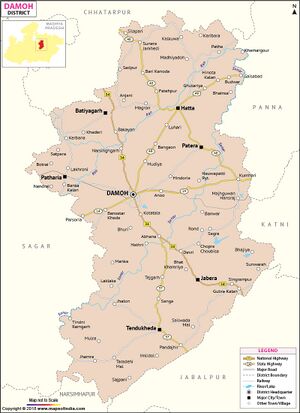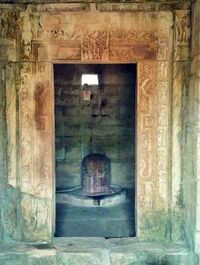Sakour
| Author:Laxman Burdak, IFS (R) |


Sakour (सकौर) is a village in Hata tahsil in Damoh district of Madhya Pradesh. It is site of Sati inscriptions. It is site of an old Shiva Temple managed by Archaeological Survey of India (ASI) Jabalpur Circle (S.No. N-MP-48).
Variants
Location
Origin
Jat Gotras Namesake
History
Shiva Temple Sakour

A lesser – known edifice of the late Gupta period is the 6th century Shiva Temple located in the obscure village of Sakour. Archaeological excavations conducted in this village have uncovered coins of Maharajadhiraja Shri Samudragupta, Maharajadhiraja Shri Chandragupta and Maharajadhiraja Shri Skandagupta indicating that this village must have been an important seat of learning, art, literature and architecture during the Gupta reign.
Historical records state that the Muslim barbarian Muhummad Ghori looted and razed several temples of the Guptas in this region to the ground in his unrelenting attack and invasion of Akhanda Bharat. This temple was totally in shambles with only the entrance doorway of the shrine in decent condition.
The temple has undergone renovations recently and now sits majestically on a rebuilt platform. This west – facing temple has only a mandapa and a garbha griha in which a Shiva Linga has been consecrated. The original temple layout is similar to the Gupta temples seen at Bhumara and Nachna and probably had a pradakshina path as well.
The temple was built with dressed stones without mortar and had an imposing shikhara over the sanctum sanctorum and a roof over the mandapa that have totally disappeared. A severely defaced inscription was found on a roof slab of the mandapa.
The entrance doorway of the garbha griha is noteworthy with three profusely decorated bands. The innermost has a random pattern that starts from above the heads of Ganga and Yamuna comprising of lotus enclosed in semi – circular frames.
The middle band has seven carvings on either side while the outermost band has a twisted garland like pattern emerging from a pot held above the head of a gana at the base of the band. The lintel has an unrecognisable panel on either side of the centrally seated Bhagawan Nataraja.
Source - Lakshmi Subramanian
Damoh Sati Inscriptions
There are a number of Sati pillars in this district, those at Hata, Hindoria and Batihagarh being well known. One of them at Hindoria is dated in 1056 AD, Bhiloni, Phutera, Jamata, Kanoda Ryotwari, Kanti, Kaithora Khamargor, Muhas, Marhiadoh, Narainpura, Piparia Ghanshiam, Raneh, Sunwaho and Sakhor contain more or less illegible inscriptions.
Reference - Hira Lal: Descriptive lists of inscriptions in the Central provinces and Berar,p.53
(113) Other Sati Inscriptions
Source - Inscriptions in the Central Provinces and Berar by Rai Bahadur Hira Lal, Nagpur, 1932,p.61-62
[p.61]: Damoh district also contains a very large number of Sati pillars, most of which are dated and mention the ruling kings, which are very useful in elucidating the history of the district. The more important ones have been noticed separately under section A. Others exist in Bangaon (बनगाँव), Banwar (बनवार), Batiagarh (बटियागढ़), Bhiloni (भिलोनी), Bandakpur (बांदकपुर), Chilghat (चीलघाट), Deogaon (देवगाँव), Hata (हटा), Hindoria (हिंडोरिया), Jamata (जामटा), Jhadoli (झडोली), Kanoda (कनोड़ा), Kanti (कांटी), (p.62), Kaithora (कैथोरा), Khamargaur (खमरगौर), Lukayan (लुकायन), Lakhroni (लखरोनी), Muhas (मुहास), Madhiadoh (मढ़ियादोह), Phutera (फुटेरा), Patna (पटना), Panari Mahant (पनारी महंत), Narsinghgarh (नरसिंहगढ़), Narainpura (नरायणपुरा), Pipariya Ghanshyam (पिपरिया घनश्याम), Puranakhera (पुराना खेड़ा), Raneh (रनेह), Sunwaho (सुनवाहो), Satsuma (सतसूमा), Sakaur (सकुर), Sailwara (सैलवाड़ा), Sitanagar (सीतानगर),
These belong to various periods and mention names of various kings and emperors notably almost all the Khilji kings of Malwa and Delhi emperors of more than one dynasty.
(119) Sakaur Pilgrim Record of 1304 AD
Source - Inscriptions in the Central Provinces and Berar by Rai Bahadur Hira Lal, Nagpur, 1932, p.63
[p.63]: Sakaur is a village 9 miles from Hata. It has a flat roofed Gupta Temple, on the roof stone of which there is a pilgrim record of much later date samvat 1361 (=1304 AD). In this village many Gupta gold coins were found.
Wiki editor Notes:
- Saka (Scythian Jats) → Sakour is a village in Hata tahsil in Damoh district of Madhya Pradesh. (119) Sakaur Pilgrim Record of 1304 AD[1] tells us ....Sakaur is a village 9 miles from Hata. It has a flat roofed Gupta Temple, on the roof stone of which there is a pilgrim record of much later date samvat 1361 (=1304 AD). In this village many Gupta gold coins were found.[2]
External links
References
- ↑ Inscriptions in the Central Provinces and Berar by Rai Bahadur Hira Lal, Nagpur, 1932, p.63
- ↑ Hiralal's Damoh Dipaka, 2nd edition, page 107,108

